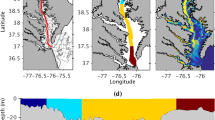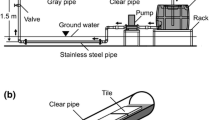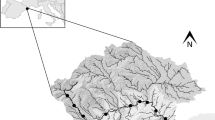Abstract
Previous studies suggest that current-driven plant transport in shallow lagoons and estuaries is associated with increased turbidity. Our hypothesis is therefore that macroalgae erode surface sediment while drifting as bedload. This ballistic effect of moving plants on surface sediment was tested in a series of controlled annular flume experiments, where simultaneous measurements of macrophytes transport and turbidity were conducted at increasing current velocities. Sediment erosion always started earlier in experiments with plants than in control experiments without plants. Turbidity increased immediately when plants started to move at current velocities of 2–4 cm s−1. From a background concentration of 7–10 mg SPM l−1, turbidity increased to 30–50 mg SPM l−1 for Ceramium sp., Ulva lactuca and Chaetomorpha linum, while the more rigid Gracilaria sp., caused much higher turbidities (50–180 mg SPM l−1). Such plant induced sediment erosion at low current velocity can explain the observed appearance of turbid waters in estuaries and lagoons in the absence of strong wind and wave action. Based on 3-D hydrodynamic modelling, it was determined that plant driven erosion occurs during most of the growth season in a shallow eutrophic estuary (Odense Fjord, Denmark).




Similar content being viewed by others
References
Amos, C. L., A. Bergamasco, G. Umgiesser, S. Carppucci, D. Cloutier, L. DeNat, M. R. Flindt, M. Bonardy & S. Crisante, 2004. The stability of tidal flats in Vernice lagoon – the results of in situ measurements using two benthic, annular flumes. Journal of Marine Systems 51: 211–241.
Decho, A. W., 1990. Microbial exopolymer secretions in ocean environments: their role(s) in food webs and marine processes. Oceanographic and Marine Biology 28: 73–153.
Decho, A. W., 2000. Microbial biofilms in intertidal systems: an overview. Continental Shelf Research 20: 1257–1273.
Duarte, C. M., 2002. The future of seagrass meadows. Environmental Conservation 29: 192–206.
Flindt, M. R., M. Carrer, J. Salomonsen, M. Bocci & L. Kamp-Nielsen, 1997. Loss, growth and transport dynamics of Chaetomorpha aerea and Ulva rigida in the Lagoon of Venice during an early summer field campaign. Ecological Modelling 102: 133–142.
Flindt, M. R., M. A. Pardal, A. I. Lillebø, I. Martins & J. C. Marques, 1999. Nutrient cycling and plant dynamics in estuaries: a brief review. Acta Oecologica 20: 237–248.
Flindt, M. R., J. Neto, C. L. Amos, M. A. Pardal, A. Bergamasco, C. B. Pedersen & F. Ø. Andersen, 2004. Plant bound nutrient transport mass transport in estuaries and lagoons. In Nielsen, S., G. Banta & M. Pedersen (eds), Estuarine Nutrient Cycling: The Influence of Primary Producers. Kluwer Academic Publishers, Dordrecht, The Netherlands: 93–128.
Flindt, M. R., C. B. Pederson, C. L. Amos, A. Levy, A. Bergamasco & P. L. Friend, 2007. Transport sloughing and settling rates of estuarine macrophytes: mechanisms and ecological implications. Continental Shelf Research 27: 1096–1103.
Glob, E., N. Holmboe, M. H. Jensen, N. Rask, C. B. Pedersen, L. Bischop-Larsen & L. Knudsen, 2006. Miljøfarlige stoffer og Ålegræs i Odense Fjord: 106 pp.
Heinzelmann, C. H. & S. Wallisch, 1991. Benthic settlement and bed erosion. Journal of Hydraulic Research 29: 355–371.
Littler, M. M. & D. S. Littler, 1980. The evolution of thalli form and survival strategies in benthic marine macroalgae: field and laboratory tests of a functional form model. The American Naturalist 116: 25–44.
Lundkvist, M., M. Grue, P. L. Friend & M. R. Flindt, 2007. The relative contribution of physical and microbiological factors to cohesive sediment stability. Continental Shelf Research 27: 1143–1152.
Markager, S. & K. Sand-Jensen, 1992. Ligth requirements and depth zonation of marine macroalgae. Marine Ecology Progress Series 88: 83–92.
MIKE 3, 2007. Scientific Documentation. DHI Publication, Copenhagen.
Paterson, D. M., 1989. Short-term changes in the erodibility of intertidal cohesive sediments related to the migratory behaviour of epipelic diatoms. Limnology and Oceanography 34: 223–234.
Paterson, D. M. & K. S. Black, 1999. Water flow, sediment dynamics and benthic biology. Advances in Ecological Research 29: 155–193.
Riisgard, H. U., M. H. Jense & N. Rask, 2008. Ecology of Baltic coastal waters. Ecological studies 197. Chapter 16. Springer-Verlag, Berlin: 361–378.
Salomonsen, J., M. R. Flindt & O. Geertz-Hansen, 1997. Significance of advective transport of Ulva lactuca for a biomass budget on a shallow water location. Ecological Modelling 102: 129–132.
Salomonsen, J., M. R. Flindt & O. Geertz-Hansen, 1999. Modelling advective transport of Ulva lactuca in the sheltered bay, Møllekrogen, Roskilde Fjord, Denmark. Hydrobiologia 397: 241–252.
Sfriso, A., 1995. Temporal and spatial responses of growth of Ulva rigida C Ag. To environmental and tissue concentrations of nutrients in the Lagoon of Venice. Botanica Marina 38: 557–573.
Sfriso, A., B. Pavoni, A. Marcomini & A. A. Orio, 1992. Macroalgae, nutrient cycles, and pollutants in the Lagoon of Venice. Estuaries 15: 517–528.
Sutherland, T. F., J. Grant & C. L. Amos, 1998. The effects of carbohydrate production by the diatom Nitzschia curvilineata on the erodibility of sediment. Limnology and Oceanography 43: 65–72.
Underwood, G. J. C. & D. M. Paterson, 1993. Seasonal changes in diatom biomass, sediment stability and biogenic stabilization in the Severn Estuary, UK. Journal of the Marine Biological Association of the United Kingdom 73: 871–879.
Viaroli, P., M. Bartoli, C. Bondavalli, R. R. Christian, G. Giordani & M. Naldi, 1996. Macrophyte communities and their impact on benthic fluxes of oxygen, sulphide and nutrients in shallow eutrophic environments. Hydrobiologia 329: 105–119.
Viaroli, P., M. Bartoli, R. Azzoni, G. Giordani, C. Mucchino, M. Naldi, D. Nizzoli & L. Tajé, 2005. Nutrient and iron limitation to Ulva blooms in an eutrophic coastal lagoon (Sacca di Goro, Italy). Hydrobiologia 550: 57–71.
Acknowledgements
This research was supported by the Danish Strategic Science Foundation through a Grant (09-063190/DSF) for the project: “Key parameters and processes affecting the re-establishment of eelgrass in estuaries and coastal waters.”
Author information
Authors and Affiliations
Corresponding author
Additional information
Guest editors: M. Holmer & N. Marbà / Dynamics and functions of seagrass ecosystems
Rights and permissions
About this article
Cite this article
Canal-Vergés, P., Vedel, M., Valdemarsen, T. et al. Resuspension created by bedload transport of macroalgae: implications for ecosystem functioning. Hydrobiologia 649, 69–76 (2010). https://doi.org/10.1007/s10750-010-0259-y
Published:
Issue Date:
DOI: https://doi.org/10.1007/s10750-010-0259-y




